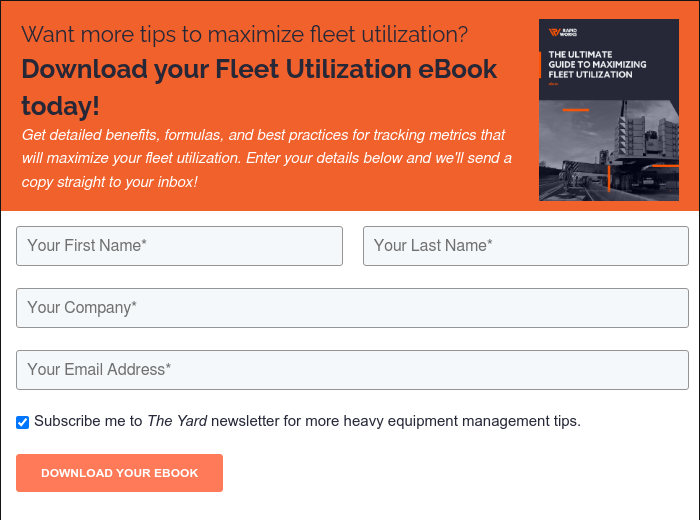How To Calculate Fleet Utilization [Formula + Metrics]

How To Calculate Fleet Utilization [Formula + Metrics]
Whether you're a fleet owner looking to better manage your fleet amid varying demand or you just want to create more effective maintenance schedules and improve compliance, you're probably asking that all-important question: How? The answer is calculating fleet utilization.
The fleet utilization formula helps you find ways to elevate each vehicle's uptime, and ultimately your fleet as a whole. It helps improve your fleet's performance and boost profitability, but keeping track of a few key metrics is a must. This guide will explain the ins and outs of the fleet utilization formula and what metrics to track to improve your fleet efficiency.
Inside this article:
- What Is Fleet Utilization?
- 5 Benefits of Maximizing Fleet Utilization
- How Do You Calculate Fleet Utilization? [metrics + formula]
- Five Advanced Fleet Utilization Metrics
- Tips for Calculating Fleet Utilization
- FAQs
What Is Fleet Utilization?
Fleet utilization works as a baseline measurement. It reads as a percentage, comparing how much a fleet is used to how much it could be used at peak capacity.
After obtaining the percentage, fleet managers can analyze current practices to identify inefficiency and institute meaningful changes.
5 Benefits of Maximizing Fleet Utilization
When done correctly, maximizing fleet utilization can deliver a significant boost to your bottom line. Some key benefits of improving your fleet utilization are:
-
Improved profitability: Whether you sell off old, underperforming vehicles in your fleet or find ways to reduce your downtime and increase your fleet's productivity, a higher utilization rate means higher profits for your company.
-
Reduced downtime: When you improve your fleet utilization, your vehicles spend less time in the yard and more time on the job, further boosting your profitability.
-
More predictable maintenance schedules: Disorganized maintenance schedules create inconsistencies in your vehicles' uptime, reducing your total fleet utilization. Monitoring your fleet utilization can help you create a consistent maintenance schedule, increasing your total fleet utilization in the long run.
-
Improved operator safety: Which vehicles in your fleet are breaking down the most, and which ones are being overused? Reviewing your fleet utilization can show you when a vehicle should be pulled out of the lineup for maintenance before a failure occurs, keeping your operators safe.
-
Better customer service: A higher fleet utilization rate means your vehicles are on-site longer, helping you complete your projects faster, resulting in greater customer satisfaction.
Data collection is essential for proper fleet utilization. The more data you record, the more accurately and swiftly you can address outstanding issues. Construction management platforms such as RapidWorks provide a centralized hub from which managers can collect, store, analyze, and monitor fleet utilization data. You'll also get fleet utilization logs so you can track key vehicle metrics and make the right decisions for your fleet at the right times.
Pro Tip: Consider leveraging a construction management platform like RapidWorks to collect data on your fleet utilization and optimize your construction management workflows.
For more about improving your fleet utilization, check out our Ultimate Guide to Maximizing Fleet Utilization here.
How Do You Calculate Fleet Utilization?
Fleet utilization comes down to tracking operating data on individual vehicles. It starts with looking at each vehicle and verifying if they are hitting the company standard regarding billable hours.
3 Metrics You Need to Calculate Fleet Utilization
The most basic formula for fleet utilization requires three metrics:
- Total number of working vehicles in a fleet.
- Total billing hours available. This is the total number of possible hours billed per day.
Typically, each company sets this number as standard and is typically related to your operating hours. Many concrete pumping companies set this at six billable hours per pump.
But for other heavy machinery, it could be as high as 10. - Total hours billed. This is the total number of actual hours billed per day, per truck.
These three numbers work to fill out a simple formula to obtain the baseline fleet utilization metric.
Sample Fleet Utilization Formula
The following formula works as a simple fleet utilization calculator:
Fleet utilization (%) = (Total hours billed / Total billing hours available) x 100
Here's how it looks in the real world. Say your fleet consists of three vehicles. Then, say each vehicle has a max work capacity of eight hours daily. After tracking utilization, records show the first truck works eight hours, the second works seven hours, and the third works five.
That comes out to 20 billable hours compared to 24 available billable hours.
With this info in hand, you can calculate the actual utilization rate:
Fleet utilization (%) = (Total hours billed = 20) / (Total billing hours available = 24) x 100 = 83%
After discovering this percentage you can identify areas for improvement, which could be anything from maintenance issues to poor routing to human error.
-2.png?width=563&height=472&name=Blue%20Modern%20Grow%20Business%20Tips%20LinkedIn%20Carousel%20(Facebook%20Post)-2.png)
5 Advanced Fleet Utilization Metrics
Calculating fleet utilization is just the first step to making sure you can get the most out of your fleet. Tracking and understanding these five advanced fleet utilization metrics can help make sure your fleet is operating at max capacity:
- Fleet Capacity: Fleet capacity is a metric used to understand the maximum amount of work a fleet can take on in a given day, week, or month.
Fleet Capacity = (Total Trucks * Total Billable Hours Available) / Days of the Work Week
- Crew Capacity: You need to track vehicle usage to bring down costs, but tracking labor is equally important. To understand your crew's maximum capacity, use the following formula:
Crew Capacity = Total Number of Operators * Total Billable Hours Available
- Work Capacity: Fleet utilization metrics require breaking down numbers by individual vehicles and operators, known as work capacity. These numbers vary depending on vehicle type and operator schedules. To do this, issue time management sheets with relevant slots for each data point for each operator and vehicle. Get a full list of the top-line work capacity metrics for heavy machinery here.
- Preventative Maintenance On-Time Completion Rate: Maintenance is always an enormous cost of running a fleet. However, preventative maintenance can significantly reduce the likelihood of costly emergency repairs and reduce downtime in the long run.
One way to measure the effectiveness of your preventative maintenance program is to understand your compliance rate. You can calculate compliance with this formula:
Preventative Maintenance Compliance = (# of Vehicles with Completed Preventative Maintenance / Total # of Vehicles) * 100
- Fuel Consumption: Fuel accounts for 22% of the cost of vehicle ownership. The key metric to track fuel consumption is miles per gallon (MPG).
Miles Per Gallon = Miles Traveled / Gallons of Gas Consumed

Tips for Calculating Heavy Equipment Fleet Utilization
Managers of heavy equipment fleets, such as a concrete pumps or hydrovac excavators, should consider the following when calculating your fleet utilization:
1. Base calculations on your total available billing hours. This should be a consistent number, so avoid including data from jobs or instances that are statistical outliers.2. Don't forget to calculate seasonality. There may be seasonal upticks or slow periods due to geographical conditions like weather, daylight, or construction. You may want to recalculate utilization percentages during construction-heavy periods with longer days, as it may reveal different areas of need. Most companies do this by changing the number of possible billed hours and calculating their annual utilization as the average of their monthly utilization percent.Example: If your company typically operates eight to ten hours and only during the weekdays, don't include jobs in the utilization formula that fall outside of the typical work week. In other words, if you have an emergency job on a weekend, leave it out or count it in a different data set, as it could falsely influence the percentage.
Example: Some hydrovac teams set their available billable hours as high as 10 in the summer months, but they may drop as low as four in the winter months. If your company works fewer hours in the winter, calculate a new percentage based on reduced workloads.
Especially for heavy equipment teams, utilization rates can vary based on month. As such, it's wise to plan accordingly to track percentages, which leads to more consistency.
3. Automatically calculate and manage utilization with a dedicated job management software. If you're looking for the best way to easily juggle many metrics, consider using a dedicated job management software platform that includes fleet utilization analysis. RapidWorks automatically calculates utilization based on your unique company profile and usage data. This way, you can access real-time data showing your performance, areas of concern, and where you need to improve to boost efficiency, safety, and profits.
Consider becoming one of the next heavy equipment companies to track fleet utilization metrics with RapidWorks. If you want to see it in action, take it for a test drive and schedule a demo here.
FAQs
1. What Does Fleet Utilization Measure?
Fleet utilization measures the amount of time your total fleet is operational relative to its maximum utilization capacity.
2. How Do You Calculate Fleet Utilization?
Fleet utilization is expressed as a percentage of your total fleet uptime. You can calculate it by adding up the billable hours for all the vehicles in your fleet and dividing that number by the total number of available hours. Then multiply that number by 100 to obtain a percentage:
Fleet utilization (%) = (Total hours billed / Total billing hours available) x 100
3. What Metrics Should You Evaluate When You Calculate Fleet Utilization?
There are several simple and advanced metrics to evaluate when you calculate your fleet utilization. The simple metrics are:
-
Total number of working vehicles in a fleet
-
Total billing hours available
-
Total hours billed
Some more advanced fleet utilization metrics that could help you maximize your fleet's profitability are:
-
Fleet capacity: The maximum amount of work your fleet can complete in a given interval of time.
-
Vehicle utilization rate: The percentage of uptime for any individual vehicle in your fleet relative to the total capacity.
-
Crew capacity: The total billing hours available for your staff.
-
Work capacity: The total amount of work your fleet and staff can complete, minus all periods of downtime.
-
Time to repair: How long your fleet spends in downtime.
-
Preventative maintenance on-time completion rate: The percentage of vehicles that have completed the appropriate preventative maintenance measures, relative to your total fleet.
-
Fuel consumption: The amount of fuel your fleet uses over a given interval of time.
4. What Can You Do to Improve Your Fleet Utilization?
To improve your fleet utilization, consider selling off old or underperforming vehicles that run for fewer billable hours in your fleet. Also, consider ways to reduce your downtime so that you can increase your billable hours. Leveraging a construction management platform like RapidWorks can help you keep track of your fleet's productivity so that you can find ways to increase your fleet utilization — and your profitability.
5. What Factors Cause Fleet Utilization to Change Over Time?
Construction is a seasonal industry. Weather conditions, the amount of daylight, and project demands can all impact the number of billable hours, so recalculate your fleet utilization periodically throughout the year.
